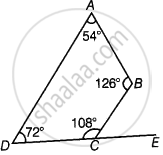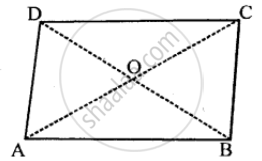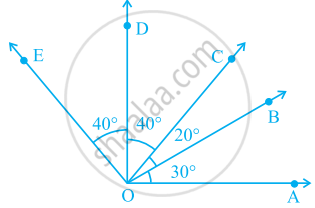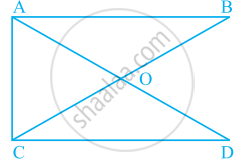Advertisements
Advertisements
प्रश्न
If angles A, B, C and D of the quadrilateral ABCD, taken in order, are in the ratio 3 : 7 : 6 : 4, then ABCD is a ______.
पर्याय
rhombus
parallelogram
trapezium
kite
उत्तर
If angles A, B, C and D of the quadrilateral ABCD, taken in order, are in the ratio 3 : 7 : 6 : 4, then ABCD is a trapezium.
Explanation:
Given in the question, ratio of angles of quadrilateral ABCD is 3 : 7 : 6 : 4.
Let the angles of quadrilateral ABCD be 3x, 7x, 6x and 4x respectively.
So, 3x + 7x + 6x + 4x = 360° ...[Sum of the all angles of a quadrilateral is 360°]
20x = 360°
x = `(360^circ)/20`
x = 18°
So, angles of the quadrilateral are:
∠A = 3 × 18° = 54°
∠B = 7 × 18° = 126°
∠C = 6 × 18° = 108°
∠D = 4 × 18° = 72°

See the figure, ∠BCE = 180° – ∠BCD ...[Linear pair axiom]
∠BCE = 180° – 108° = 72°
∠BCE = ∠ADC = 72°
Now, BC || AD ...[The corresponding angles are equal]
The sum of co interior angles is:
∠A + ∠B = 126° + 54° = 180°
And ∠C + ∠D = 108° + 72° = 180°
Hence, ABCD is a trapezium.
APPEARS IN
संबंधित प्रश्न
Complete of the following, so as to make a true statement:
The measure of each angle of a convex quadrilateral is ..... 180°.
From the following figure find;
- x
- ∠ABC
- ∠ACD
In quadrilateral PQRS, ∠P : ∠Q : ∠R : ∠S = 3 : 4 : 6 : 7.
Calculate each angle of the quadrilateral and then prove that PQ and SR are parallel to each other
(i) Is PS also parallel to QR?
(ii) Assign a special name to quadrilateral PQRS.
The angles A, B, C and D of a quadrilateral are in the ratio 2 : 3 : 2 : 3. Show this quadrilateral is a parallelogram.
In a parallelogram ABCD, its diagonals AC and BD intersect each other at point O.

If AC = 12 cm and BD = 9 cm ; find; lengths of OA and OD.
One angle of a hexagon is 140° and the remaining angles are in the ratio 4 : 3 : 4 : 5 : 4. Calculate the measures of the smallest and the largest angles.
In quadrilateral WXYZ, the pairs of opposite angles are ______.
In the given figure.
∠COA is a/an ______ angle
The number of straight angles in figure is ______.
Draw a rough sketch of a quadrilateral KLMN. State two pairs of opposite angles.
